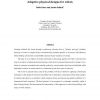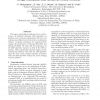CEC
2009
IEEE
14 years 18 days ago
2009
IEEE
The SYMBRION project stands at the crossroads of Artificial Life and Evolutionary Robotics: a swarm of real robots undergoes online evolution by exchanging information in a decentr...
IJON
2008
14 years 1 months ago
2008
This article depicts the approach used to build the Topos application, a simulation of two-wheel robots able to discern real complex sounds. Topos is framed in the nouvelle concep...
ALIFE
1998
14 years 2 months ago
1998
Creating artificial life forms through evolutionary robotics faces a “chicken and egg” problem: learning to control a complex body is dominated by problems specific to its s...
NN
2000
Springer
14 years 2 months ago
2000
Springer
We address two issues in Evolutionary Robotics, namely the genetic encoding and the performance criterion, also known as fitness function. For the first aspect, we suggest to enco...
CORR
2004
Springer
14 years 2 months ago
2004
Springer
An approach to robotics called layered evolution and merging features from the subsumption architecture into evolutionary robotics is presented, and its advantages are discussed. T...
EL
2008
14 years 2 months ago
2008
Research paper Purpose of this paper This paper describe an integrated hardware/software system based on Evolutionary Robotics and its application in Edutainment context. Design/me...
CCIA
2006
Springer
14 years 6 months ago
2006
Springer
In this paper, we use a massive modular architecture for the generation of complex behaviours in complex robots within the evolutionary robotics framework. We define two different ...
SEAL
1998
Springer
14 years 7 months ago
1998
Springer
This paper empirically investigates the use and behaviour of Evolution Strategies (ES) algorithms on problems such as function optimisation and the use of evolutionary artificial ...
ECAL
2001
Springer
14 years 7 months ago
2001
Springer
Some benefits of a dialogue between evolutionary robotics and developmental ethology are presented with discussion of how developmental models might inform approaches to evolution...
CEC
2009
IEEE
14 years 7 months ago
2009
IEEE
— The bootstrap problem is often recognized as one of the main challenges of evolutionary robotics: if all individuals from the first randomly generated population perform equal...






